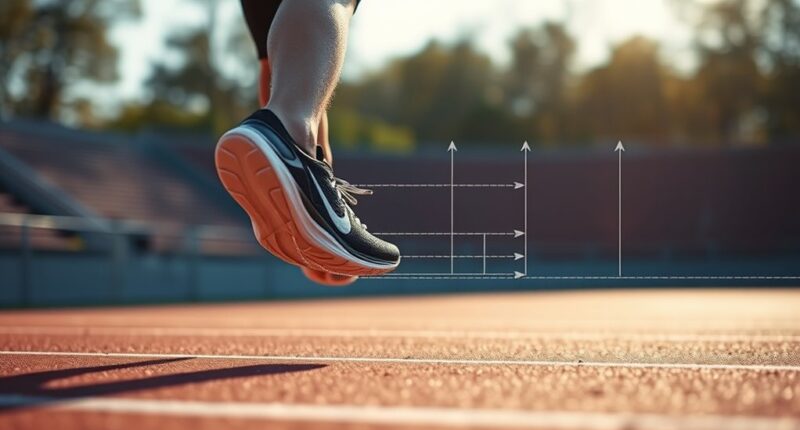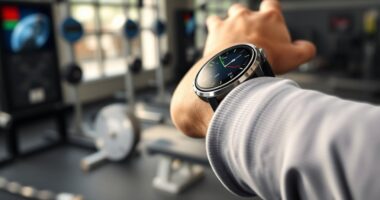Ground contact time is how long your foot stays on the ground during each stride, impacting your speed and running efficiency—shorter times often mean quicker, more efficient movement. Vertical oscillation is the amount of up-and-down bounce you have with each step; less excess bounce conserves energy and helps you run more smoothly. By monitoring and adjusting these factors, you can improve your performance and run more comfortably—you’ll find more detailed insights ahead.
Key Takeaways
- Ground contact time measures how long your foot stays on the ground during each stride, affecting running efficiency.
- Vertical oscillation is the amount of upward movement with each step, impacting energy expenditure.
- Shorter ground contact times and controlled vertical oscillation improve running economy and speed.
- Excessive vertical bounce wastes energy and reduces forward momentum, decreasing efficiency.
- Monitoring these metrics helps runners optimize stride, conserve energy, and enhance overall performance.

Understanding ground contact time and vertical oscillation is essential for optimizing your running performance. These two metrics directly influence your running economy, which is how efficiently your body uses energy during each stride. When you focus on reducing your ground contact time, you can improve your overall speed and stamina because less time spent on the ground means you’re moving forward more quickly. Similarly, vertical oscillation—the amount you bounce up and down with each step—affects how efficiently you transfer energy with each stride. Excessive vertical movement wastes energy and can slow you down, while controlled oscillation helps maintain momentum and conserve energy.
By paying attention to your ground contact time, you can fine-tune your stride length and cadence for better performance. Shorter ground contact times usually indicate a quicker, more efficient stride, enabling you to maintain a consistent pace without wasting energy on unnecessary vertical movement. Shortening your contact time also encourages a more forward-focused stride, which can improve your running economy. When your foot strikes the ground and quickly pushes off, you’re using less energy to sustain your pace, reducing fatigue over long distances. This efficiency makes a significant difference whether you’re training for speed or endurance.
Focusing on shorter ground contact times enhances efficiency and sustains pace during your runs.
Vertical oscillation plays a vital role in how your body manages energy. Too much bounce means you’re lifting your body more than necessary with each stride, which doesn’t contribute to forward movement and instead drains your energy reserves. On the other hand, maintaining a moderate vertical oscillation allows you to harness energy more effectively, translating to a smoother and more economical running style. As you improve your form, you’ll notice that your stride length naturally adjusts; a longer stride isn’t always better if it increases vertical oscillation or ground contact time unnecessarily. Instead, the goal is to find a balance where your stride length complements your cadence, making your running more efficient.
Incorporating awareness of these factors into your training can help you develop a more efficient running style. Use a GPS watch or footpod to monitor your ground contact time and vertical oscillation during runs. Aim to reduce contact time without sacrificing stride length or comfort, and keep vertical oscillation in check to avoid unnecessary vertical movement. Over time, these adjustments will enhance your running economy, allowing you to run faster with less effort. Whether you’re aiming for a new personal best or simply want to run more comfortably, understanding and optimizing your ground contact time and vertical oscillation will make a noticeable difference in your performance. Regular training with a focus on these metrics can lead to sustained improvements in efficiency and speed.
Frequently Asked Questions
How Can I Measure My Ground Contact Time Accurately?
To measure your ground contact time accurately, use a running watch or a footpod that tracks your cadence and contact duration. Focus on maintaining consistent shoe cushioning to get reliable readings, and run at your usual pace. These devices analyze your stride, giving precise data on how long your foot stays on the ground—helping you optimize your running efficiency and prevent injuries.
What Is an Ideal Vertical Oscillation for Marathon Runners?
Think of vertical oscillation as the bounce of a basketball—too high, and you’re wasting energy; too low, and you might not be propelling forward efficiently. For marathon runners, an ideal vertical oscillation hovers around 8-10 centimeters, optimizing running economy and stride length. Keeping this balance helps you conserve energy, maintain momentum, and run smoother, making each step a calculated move toward your personal best.
Does Lowering Ground Contact Time Improve Running Efficiency?
Lowering your ground contact time can improve running efficiency by enhancing your running biomechanics. When you spend less time on the ground, you reduce energy loss and increase propulsion. Wearing shoes with appropriate cushioning supports this, absorbing shock without hindering your stride. Focus on maintaining a quick, light foot strike, which helps optimize your biomechanics, leading to better performance and reduced fatigue during your runs.
How Does Vertical Oscillation Affect Injury Risk?
Vertical oscillation can increase your injury risk by adding unnecessary vertical motion, which strains your joints and muscles. Poor running biomechanics with high oscillation may lead to overuse injuries like stress fractures or tendinitis. To prevent injuries, focus on maintaining efficient biomechanics, keeping your vertical movement controlled, and improving your running form. This helps reduce impact forces and keeps your body aligned, supporting injury prevention during your runs.
Can Training Reduce Vertical Oscillation Effectively?
Think of your running form as a finely tuned instrument—you can make small adjustments for a smoother performance. Yes, training can reduce vertical oscillation effectively through cadence optimization and plyometric drills. By increasing your cadence, you take quicker, lighter steps, minimizing unnecessary bounce. Plyometric exercises strengthen your muscles, improving your running economy. Together, these techniques help you run more efficiently and lower injury risk by reducing excess vertical movement.
Conclusion
Understanding ground contact time and vertical oscillation is like revealing a secret to running more efficiently. When you optimize these factors, your stride becomes smoother, like a graceful bird gliding through the air. It’s not just about speed; it’s about feeling lighter and more in control with every step. So, pay attention to your form and harness these insights—your running experience can transform into a dance that’s effortless and powerful.









